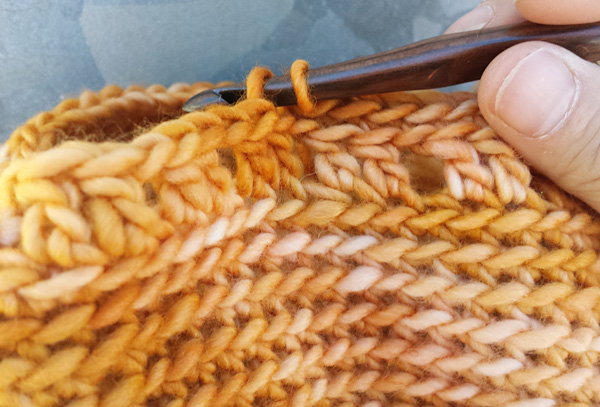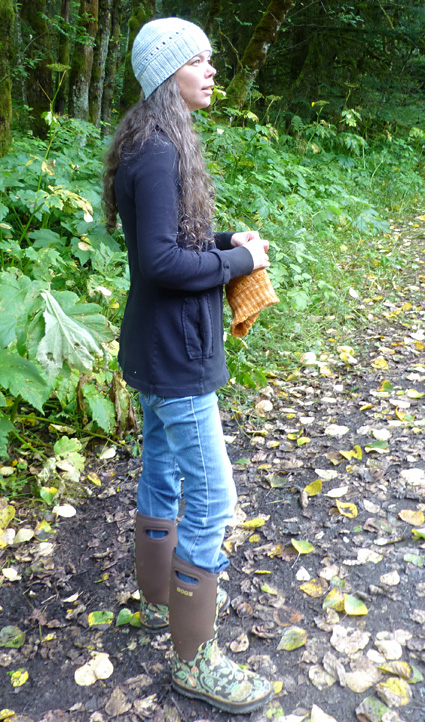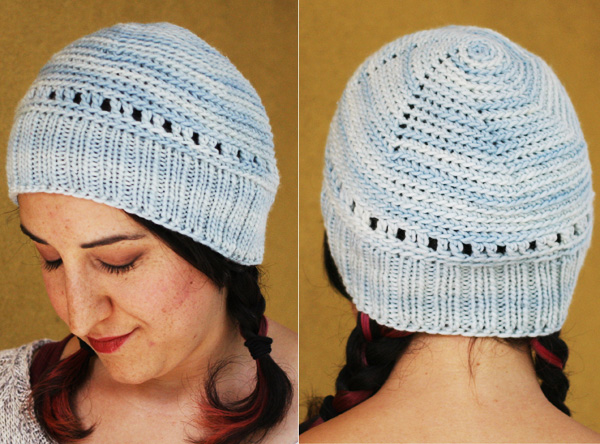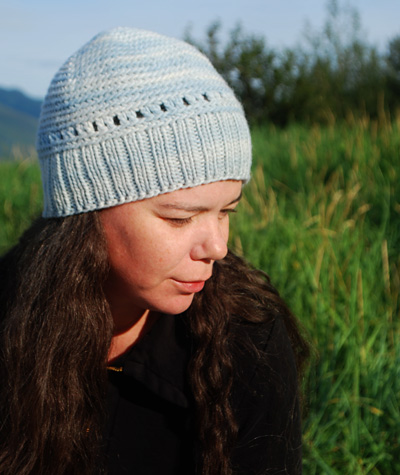

|
|
Tweet
|
|
|
|
Full Circle In this column, we'll bring our collaborations to life and you get to try your hand at what we discover. Part of the fun of this project has been working as a duo on design -- something that's typically a solitary enterprise. Amy is in Juneau, Alaska, and Miriam is in Salt Lake City, Utah. So, from desert and rainforest, we come together through the magic of Google Hangouts. We dig virtually through our yarn stashes and find what we have in common. We text pictures of swatches to each other, comparing fabric and stitches. We also pay attention to how knitters and crocheters around the internet have been mixing media. We'll point you to techniques we find where people integrate crochet into their knitting in innovative ways. For instance, Franklin Habit, fellow Knitty columnist with an eye for the unusual and arcane -- and a knitter unafraid to brandish his crochet hook in public -- has been working on a pair of Victorian bathing drawers to bring along on his upcoming nautical knitting cruise. Recently, he posted on his blog from an undisclosed location, and showed us all his leg openings where crochet is playing beautifully with the knitted body of the drawers. One of the places where crochet shines as a medium is in working small rounds of fabric starting at the center. Using crochet to start the crown of a hat means you don't need to fiddle with multiple needles holding just a handful of stitches. You can start with a tiny chain or just a loop of yarn. Enter the Hybrid Hat. We've created a hat that uses crochet for the crown and knitting for the ribbed sides. In this hat, if you're new to crochet, you'll become accustomed to working in the round in one of our favorite stitches: single crochet through the back loop (sc-blo -- see image below). Often, crochet is worked in reversible stitches: that means it looks the same from both sides, but it creates a much thicker fabric (similar to garter stitch in knitting). This is where the notion that crochet eats up more yarn than knitting comes from. Some crochet stitches do tend to gobble up yarn, whereas others are pretty equivalent to their knitted cousins. Working in just the back loop of the stitch in the round creates a soft flexible fabric with a clear Right Side and Wrong Side.
|
 |
 |
by Amy O'Neill Houck This hat is worked from the crown down to the brim, so the crown will be increased to the full hat circumference. For these increases to spiral, we're simply stacking one round of increases on top of the previous round in the same way that you would stack decreases on a bottom-up knitted hat. You will work the increase (2 sc in the same stitch) in the 2nd stitch of the increase from the round below. Once you're comfortable spotting the increases, you may not need stitch markers, but if it's helpful, you can put a split ring marker (or coil-less safety pin) in the 2nd stitch of each increase, and just move it up each round to keep track. Another advantage of crocheting the crown of this hat is sizing. Starting a circle from the center has the same advantage as building a garment from the neck down. You can try it on and size it as you go. To size the Hybrid Hat, you'll need to measure your head. You'll want a full circumference an inch smaller than what you've measured so the hat will stay on. If you just want to make a basic hat, you can go for a finished circumference of 22 inches which is an average head size. This means you'll increase until the crown measures 21 inches. Measuring the circumference of a piece of fabric can be tricky. It's much easier to measure the diameter. So, we've used a calculator to convert diameter to circumference. You can do the same. Just be sure to measure from one increase point to another. Then do the math to see if your hat is the right size. |
SIZE FINISHED MEASUREMENTS: |
MATERIALS Notions |
| GAUGE |
Since you're crocheting to a particular circumference instead of a number of stitches, you can work this pattern in any gauge. As long as you finish the crown shaping with a full round, then you should end with a multiple of 6 sts and the Filet Round and 2 x 1 ribbing will work out. If you use a different weight of yarn, pick a hook that creates a nice, soft fabric. Choose a needle one size smaller than your hook for the ribbing. |
|
PATTERN NOTES |
Ch: chain For new or newish crocheters, here is some online assistance:

|
|
DIRECTIONS |
 Using crochet hook chain 4 and join in a ring. Round 1: Ch 1, 6 sc in chain loop, mark start of round with removable marker. Round 2: Inc 6 times. (12 sts) Round 3: (1 sc-blo, inc) 6 times. 18 sts. Round 4: (2 sc-blo, inc) 6 times. 24 sts. Round 5: (3 sc-blo, inc) 6 times. 30 sts. Round 6: (4 sc-blo, inc) 6 times. 36 sts. Round 7: (5 sc-blo, inc) 6 times. 42 sts. Continue increasing evenly until the desired head circumference is reached. You can use this site to help you calculate the correct diameter for your desired finished head size. Lay the crown of the hat flat and measure from increase point to increase point. Remember you want a circumference 1 inch smaller than your head measurement. Sides Ribbing With the needle, pick up and knit 1 st through the back loop of each crochet stitch Count your stitches. You need a multiple of 3 sts for the ribbing. Ribbing round: K1, p1, [k2, p1] to last st, k1. Bind off using Jeni's Surprisingly Stretchy Bind-Off. |
| FINISHING |
Weave in ends and block. |
| ABOUT THE DESIGNERS |
 |
| Pattern & images © 2013 Amy O'Neill Houck + Miriam Felton. Contact Miriam |